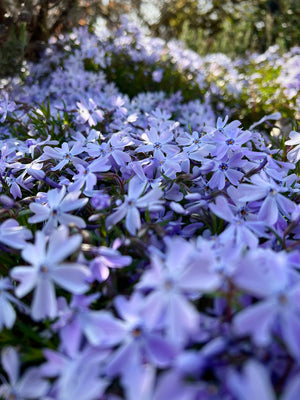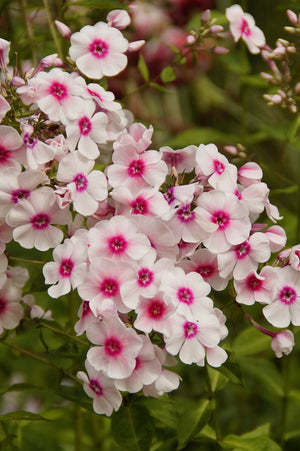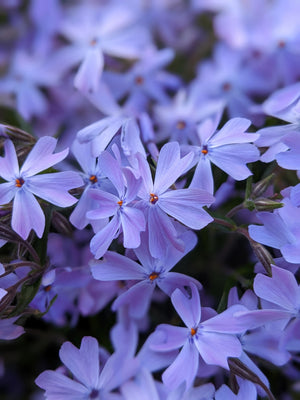The Phlox Guide
Phlox, with its vibrant colors and charming blooms, adds a touch of beauty and grace to any garden landscape. Known for their clusters of star-shaped flowers and lush green foliage, phlox plants are perfect for creating eye-catching borders, beds, and rock gardens. Their blooms come in a wide range of colors, including shades of pink, purple, red, white, and blue, making them a favorite among gardeners looking to add dynamic and visually appealing elements to their garden designs. Whether you're aiming to attract pollinators, create a cottage garden, or add a burst of color to your outdoor space, phlox offers a reliable and enchanting solution. With minimal maintenance requirements and adaptability to various soil types and light conditions, phlox is a hassle-free addition to any garden. Explore our Phlox Guide to learn more about cultivating and caring for these delightful perennials, and discover how to incorporate them into your garden for lasting beauty and enjoyment.

About
Phlox, belonging to the Polemoniaceae family, is a versatile and beloved group of plants known for their vibrant colors and delightful clusters of star-shaped flowers. Native to North America, phlox species are highly valued for their ornamental appeal and ability to attract pollinators such as butterflies, bees, and hummingbirds. These charming perennials are a staple in many gardens, offering long-lasting blooms and lush foliage that add beauty and interest to various landscape settings.
There are several types of phlox, each with unique characteristics and growing habits:
- Garden Phlox (Phlox paniculata): Known for its tall stature and large flower clusters, garden phlox is perfect for creating striking vertical accents in garden beds and borders. It blooms from mid-summer to early fall, offering a continuous display of color.
- Creeping Phlox (Phlox subulata): This low-growing variety is ideal for ground cover, rock gardens, and cascading over walls. Creeping phlox produces a carpet of vibrant blooms in spring, creating a stunning visual effect.
- Woodland Phlox (Phlox divaricata): Suited for shaded areas and woodland gardens, this phlox variety features loose clusters of fragrant flowers that bloom in spring. Its delicate appearance and pleasant scent make it a popular choice for naturalistic plantings.
Phlox plants thrive in well-drained soil and prefer locations with full sun to partial shade. They are relatively low-maintenance, requiring minimal care once established. Phlox is also known for its resistance to pests and diseases, adding to its appeal as a reliable and easy-to-grow perennial.
In addition to their ornamental value, phlox flowers are often used in cut flower arrangements, adding a burst of color and fragrance to indoor spaces. Their long blooming period and ability to attract pollinators make them a valuable addition to pollinator gardens and wildlife-friendly landscapes.
Explore the diverse world of phlox in our comprehensive guide, where you'll find insights into planting techniques, care practices, and creative ways to incorporate these vibrant plants into your garden. Whether you're enhancing borders, creating ground covers, or designing striking container displays, phlox offers endless possibilities for enriching your outdoor space.

Planting
Phlox plants require specific planting conditions to ensure their successful establishment and flourishing growth. Here are some essential guidelines for planting and caring for phlox:
Soil: Phlox thrives in well-drained, fertile soil with a pH level ranging from 6.0 to 7.0. Prepare the planting site by loosening the soil and incorporating organic matter such as compost or well-rotted manure to improve soil structure and fertility. Good drainage is crucial to prevent root rot, especially for creeping and woodland phlox.
Sunlight: Phlox prefers full sun to partial shade. Garden phlox and creeping phlox thrive in full sun, requiring at least six hours of direct sunlight per day for optimal blooming. Woodland phlox prefers partial shade, making it ideal for shaded garden areas or woodland settings.
Watering: Adequate watering is essential during the initial growth stages. After planting, water the phlox deeply to establish strong roots. Maintain consistent soil moisture, particularly during dry periods, but avoid waterlogging, which can lead to root rot.
Mulching: Apply a layer of organic mulch around the base of your phlox plants to retain moisture, suppress weed growth, and regulate soil temperature. Use materials like wood chips, bark, or compost, ensuring the mulch is kept a few inches away from the plant stems to prevent moisture-related issues.
Spacing: Plant phlox 12 to 24 inches apart, depending on the variety and their mature size. Proper spacing ensures adequate air circulation, reducing the risk of fungal diseases and promoting healthy plant development.
Planting Time: The best time to plant phlox is in the spring or early fall when temperatures are moderate. This allows the plants to establish strong root systems before the onset of extreme weather conditions.
Depth: When planting phlox, ensure the top of the root ball is level with the soil surface. Planting too deeply can hinder growth and lead to root rot.
By following these planting and care instructions, you can ensure the successful establishment and thriving growth of your phlox plants. With proper attention, phlox will bring vibrant color and delightful blooms to your garden, enhancing its charm and appeal for years to come.

Care
Phlox plants require specific care to ensure their optimal growth and health. Here are some general guidelines for the care of phlox:
Watering: During the growing season, provide regular watering to your phlox plants. Aim to keep the soil consistently moist but not waterlogged. Water deeply at the base of the plant to encourage deep root growth and to prevent fungal diseases. Adjust watering frequency based on rainfall and weather conditions.
Pruning: Pruning is essential for maintaining the shape and vigor of phlox plants. Deadhead spent flowers to encourage continuous blooming and prevent self-seeding. In late fall, after the first frost, cut back the stems of garden phlox to about 1-2 inches above the ground. Creeping phlox can be lightly trimmed after flowering to maintain a tidy appearance.
Fertilizing: Fertilizing can help boost the growth and blooming of phlox plants. Apply a balanced, slow-release fertilizer in early spring when new growth begins and again in mid-summer. Follow the recommended dosage on the product label and avoid over-fertilizing, as this can lead to excessive foliage growth at the expense of flowers.
Soil and Sunlight: Ensure that phlox is planted in well-drained, fertile soil with a pH level ranging from 6.0 to 7.0. Phlox thrives in full sun to partial shade, depending on the variety. Garden phlox and creeping phlox prefer full sun, while woodland phlox does well in partial shade.
Mulching: Apply a layer of organic mulch around the base of your phlox plants to retain moisture, suppress weed growth, and regulate soil temperature. Use materials like wood chips, bark, or compost, ensuring the mulch does not touch the plant stems directly to prevent rot and fungal issues.
Pests and Diseases: Phlox can be susceptible to pests such as spider mites, aphids, and powdery mildew. Inspect your plants regularly and treat any infestations promptly with appropriate organic or chemical controls. Ensuring good air circulation around the plants and avoiding overhead watering can help reduce the risk of fungal diseases.
Dividing: Phlox benefits from occasional division to maintain vigor and prevent overcrowding. Divide the plants every 3-4 years in early spring or late summer. Dig up the clump, separate it into smaller sections with healthy roots and shoots, and replant them at the same depth as the original plant.
Winter Care: In colder climates, protect your phlox plants from harsh winter conditions by applying a layer of mulch to insulate the roots. Remove any debris from around the plants in the fall to reduce the risk of pests and diseases overwintering in the garden.
By following these care guidelines, your phlox plants will thrive and add vibrant color and delightful blooms to your garden for years to come. With their resilience, low maintenance requirements, and stunning flowers, phlox are a valuable addition to any landscape, providing year-round interest and charm.

How To Use
Phlox offers versatility and can be utilized in various ways to enhance your landscape. Here are some recommendations based on their characteristics:
Colorful Borders: Use phlox to create vibrant borders in your garden. Plant them along pathways, garden beds, or driveways to add splashes of color and texture. Their tall, upright growth and clusters of star-shaped flowers create a dramatic effect when planted en masse.
Ground Cover: Creeping phlox is perfect for use as a ground cover in rock gardens, slopes, or along garden edges. Its dense, spreading habit helps suppress weeds and provides a carpet of vibrant blooms in spring.
Pollinator Gardens: Phlox flowers attract pollinators like bees, butterflies, and hummingbirds. Plant them alongside other pollinator-friendly plants to create a thriving ecosystem that supports local wildlife.
Cottage Gardens: Phlox fits perfectly into cottage garden designs, where their informal, natural look blends well with other traditional garden plants. Combine them with roses, delphiniums, and foxgloves for a charming, old-fashioned garden.
Cut Flower Arrangements: Phlox blooms make excellent additions to cut flower arrangements. Harvest the flowers when they are fully open and use them in bouquets, centerpieces, or floral displays to bring their beauty indoors.
Mixed Perennial Beds: Incorporate phlox into mixed perennial beds for continuous seasonal interest. Pair them with early-blooming perennials, summer flowers, and fall foliage plants to create a dynamic and visually appealing garden composition.
Rock Gardens: Creeping phlox and other low-growing varieties are ideal for rock gardens. Plant them among rocks or gravel to add vibrant color and texture to your rock garden.
Containers: Phlox can be grown in containers, making them perfect for patios, balconies, or entryways. Plant them in pots or mixed containers to enjoy their beauty up close. Ensure the containers have good drainage to prevent waterlogging.
Erosion Control: Creeping phlox’s dense root system makes it excellent for erosion control on slopes and embankments. Plant it in areas prone to erosion to stabilize the soil and prevent runoff.
Seasonal Displays: Use phlox in seasonal displays to create stunning visual effects. Their diverse color palette allows for beautiful combinations that change with the seasons, adding excitement and variety to your garden.
When incorporating phlox into your landscape, consider their growth habits, sunlight requirements, and soil preferences. By choosing the right placement and utilizing their versatile nature, phlox plants can enhance the beauty and functionality of your outdoor space, providing year-round interest and vibrant blooms.
Conclusion
Phlox is a vibrant and versatile addition to any garden landscape. With its charming star-shaped blooms and lush foliage, phlox brings a burst of color and elegance to your outdoor space. Their ease of care and adaptability to various soil types and light conditions make them a favorite among gardeners of all levels. By following proper planting and maintenance techniques, you can fully harness the potential of phlox to elevate your garden and create a lasting impact.
Whether you seek to create colorful borders, ground covers, or pollinator-friendly gardens, phlox can fulfill a variety of roles in your landscape design. Plant them individually to highlight their unique beauty, or cluster them together for a dramatic visual display. Phlox's ability to attract pollinators, provide stunning cut flowers, and contribute to seasonal garden interest adds to their appeal, making them a valuable addition to any garden.
Beyond their ornamental value, phlox contributes to the overall health and beauty of your garden ecosystem by attracting beneficial insects and providing habitat for pollinators. Their low maintenance requirements and long blooming period make them an excellent choice for sustainable gardening. With their enduring beauty, versatility, and ecological benefits, phlox plants bring natural allure and vibrant charm to your outdoor environment, enriching your gardening experience and enhancing the overall beauty of your landscape.

